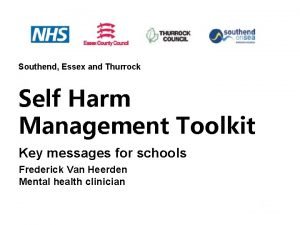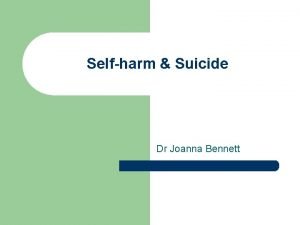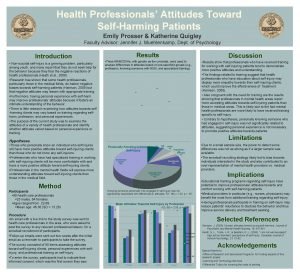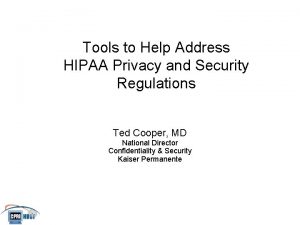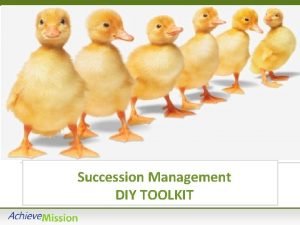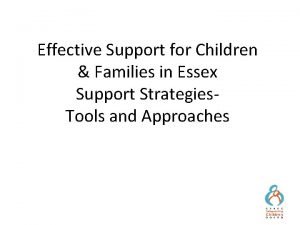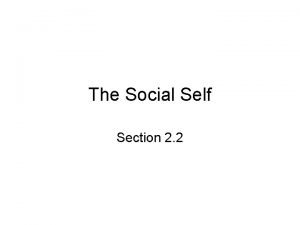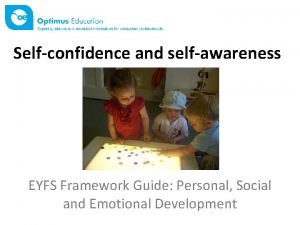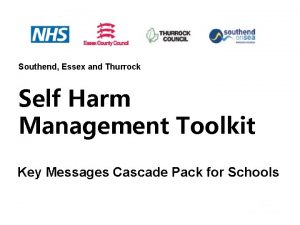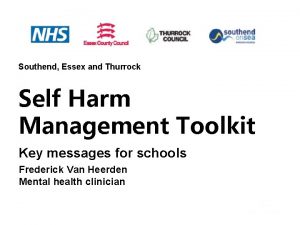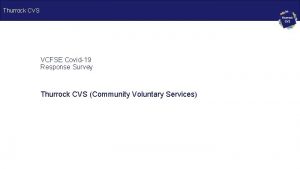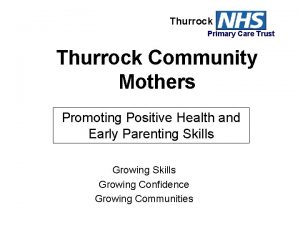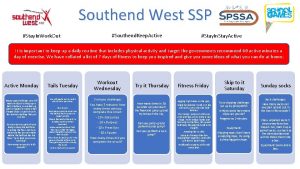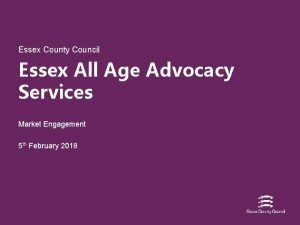Southend Essex and Thurrock Self Harm Management Toolkit















- Slides: 15

Southend, Essex and Thurrock Self Harm Management Toolkit Key messages for schools Frederick Van Heerden Mental health clinician

Before we start………. . • Emotional wellbeing - health and safety!

Background: • • • Future in Mind: transformation of children’s mental health Five year local transformation plan ‘Open Up, Reach Out’ Review of suicide prevention guidance document – 2015/2016.

Process………. 1. We’ve looked at data, evidence and best practice. 2. Partners identified who worked on the Toolkit. 3. Draft Toolkit produced. 4. Consultation.

Consultation and feedback: • Essex school safeguarding forums • Schools and school nurses – Essex • Education, Special Educational Needs and Disabilities (SEND), Essex County Council (ECC) • Social care staff, ECC • Responses from suicide prevention toolkit focus groups (2016) • Youth service, ECC • Virgin Care, 0 -19 Service, Essex • Directors of Nursing, North East London NHS Foundation Trust (NELFT) • Clinical feedback across the Emotional Wellbeing and Mental Health Service (EWMHS) • Clinical Commissioning Groups (CCGs) – Basildon & Brentwood, Thurrock, Mid Essex • Named nurses - CCGs • Public health – Thurrock • Voluntary sector • District council – Harlow • Southend consultation feedback • Young people engagement feedback – NELFT.

“It’s good to TALK but even better to be HEARD. ”

So what does the Toolkit look like………? SET emotional wellbeing and mental health information portal for schools: https: //schools. essex. gov. uk/pupils/Emotional_Wellbei ng_and_Mental_Health_Information_Portal_for_School s/Pages/Risk-Taking-Behaviour. aspx


What is Self Harm? The term “self harm” is used to describe a wide range of behaviours. Self harm is often understood to be a physical response to an emotional pain. It can be seen as an intentional act of damaging or injuring one’s body, irrespective of apparent motivation, though is usually a way of expressing or coping with overwhelming emotional distress. Video from Mind around information on self harm: youtube. com/watch? v=f. SEt. Ubc 8 JDU

Aims of the Self Harm Management Toolkit • Increase school staff understanding and awareness of emotional wellbeing difficulties for young people • Support staff to be aware of risk factors and signs that are associated with emotional distress self harming behaviour in young people • Provide guidance for educational settings (and staff within them) dealing with students who present with emotional distress and self harming behaviour • Raise awareness in educational settings of what support is available locally in dealing with young people who find themselves in emotional turmoil • Provide online support references to school staff, parents and young people.

Toolkit – Key Sections • • . Spotting the signs How do you respond Assessing risk Confidentiality and information sharing Talking to children and young people Do’s and don’ts Distraction/coping strategies.

Roles and Responsibilities • What is your individual responsibility? • What is in place to help you manage this? • Schools own safeguarding procedures; what do they do in house/support child young person to do, how do they escalate through their own safeguarding routes?

Key Dos – Full Details Page 15 Toolkit • Make time. Talk to the child or young person about their selfharming • Listen to what is being said and check your understanding • Respond with concern rather than anxiety or distaste • Find out how they are feeling – are there ups and downs? Are there underlying difficulties? • Ask about existing coping strategies and suggest additional strategies • Act appropriately in line with policy of confidentiality • Speak to other agencies or nominated people within the parameters of confidentiality • Look after yourself; ensure you have someone to support you and talk things through with.

Key don’ts – Full details page 15 Toolkit • Don’t tell them to stop self harming or give them an ultimatum • Do not ignore self harm however superficial it may seem to you, or assume someone else is already helping them • Do not make judgements or promises you can’t keep.

Additional support/resources available • Please make use of the extensive support and advice contained within the Toolkit • The appendices section contains a wealth of information and support around children and young people’s mental health.
 Self harm toolkit essex
Self harm toolkit essex Homeless shelters southend
Homeless shelters southend Southend high school for girls
Southend high school for girls Southend 2050
Southend 2050 What is the difference of actual self and ideal self
What is the difference of actual self and ideal self Joanna self harm
Joanna self harm Emily self harm
Emily self harm Hipaa security rule self assessment toolkit
Hipaa security rule self assessment toolkit Talent management toolkit
Talent management toolkit Effective support for children and families in essex
Effective support for children and families in essex Joint meeting of essex and union counties
Joint meeting of essex and union counties Herts and west essex stp
Herts and west essex stp Reference of globalization
Reference of globalization Macbeth famous lines
Macbeth famous lines I self and me self difference
I self and me self difference Self confidence and self awareness eyfs
Self confidence and self awareness eyfs
